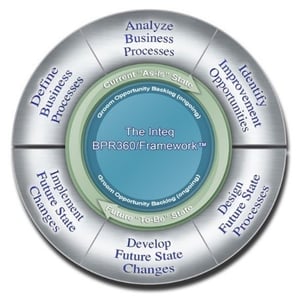I am frequently asked to distill the key steps of Business Process Reengineering (BPR) and process reengineering into high level conceptual sound bites when discussing BPR with an organization’s management team. This is particularly important in order to have the right level of conversation with senior management and leadership. And, at that level, the conversation inevitably (and appropriately) gravitates to the relationship between BPR and the organization's business strategy.
This post presents a sound bite of the six key steps of BPR – important and useful content on its own. And, it provides the context for the discussion at the end of the post of the relationship between BPR and organizational strategy.
The Six Key Steps of Business Process Reengineering

Define Business Processes. Map the current state (work activities, workflows, roles and reporting relationships, supporting technology, business rules, etc.). See my whitepaper, “10 Perilous Misconceptions of Censuring Current State Mapping & Analysis” for additional insight.
-
Analyze Business Processes. Identify gaps, root causes, strategic disconnects, etc. in the context of improving organizational effectiveness, operational efficiency and in achieving organizational strategic objectives.
-
Identify and Analyze Improvement Opportunities. Identify, analyze and validate opportunities to address the gaps and root causes identified during analysis. This step also includes identifying and validating improvement opportunities that are forward facing – often strategic transformational opportunities that are not tethered to current state process.
-
Design Future State Processes. Select the improvement opportunities identified above that have the most impact on organizational effectiveness, operational efficiency, and that will achieve organizational strategic objectives. Make sure to select opportunities for which the organization has the budget, time, talent, etc. to implement in the project timeframe. Create a forward-facing future-state map that comprehends the selected opportunities.
-
Develop Future State Changes. Frequently overlooked (and a key root cause in failed BPR initiatives), this is where the above opportunities are operationalized before implementation. New workflows and procedures need to be designed and communicated, new/enhanced functionality is developed and tested, etc. Changes and opportunities cannot be implemented until they are operationalized.
-
Implement Future State Changes. Classic implementation based on dependencies among changes/opportunities, change management, project management, performance monitoring, etc.
Business Strategy and BPR – The Secret Sauce
The key point I want to make in this blog is the distinction between business-as-usual improvement opportunities and strategic improvement opportunities. The distinction is essential in selecting the opportunities to move forward into design, development and implementation.
Business-as-usual improvement opportunities are those opportunities that improve, but do not fundamentally change current processes. These are the things that you do (typically incremental changes) to improve operational efficiency and "lean" the process – i.e. reduce waste, errors, cycle time, etc.
To be clear, I am not diminishing the importance of business-as-usual opportunities. Business-as-usual opportunities are ongoing and have significant impact on the bottom line, but they do not move the needle with respect to enabling an organization to achieve strategic objectives. See my whitepaper “Lean – Getting Early Wins from BPR” for a detailed discussion of business-as-usual improvement opportunities.
Strategic improvement opportunities, on the other hand, enable organization to do new (as well as existing) things in new ways. Strategic opportunities enable and support an organization's strategic objectives – new product lines, new approaches to customer service and engagement, speed and quality of fulfillment, etc.
It’s my experience (100% of the time) that in a BPR initiative we identify more high-value transformational opportunities for improving business processes (in addition to business-as-usual opportunities) than an organization has the time, budget and resources to implement in the short run. So, how do you shortlist from a group of high-value transformation opportunities? An essential part of shortlisting is to identify which opportunities move the needle the most toward enabling an organization to achieve strategic objectives. BPR opportunities, unless clearly tied to strategic objectives, are untethered, and therefore open to subjective and political shortlisting.
BPR Training Course
BPR requires new ways of thinking to achieve break-through results in organizational effectiveness and operational efficiency. Inteq's Business Process Reengineering Training Course provides you and your team with the skills, techniques and methods you need to apply the right level of change to the right functions and processes at the right time.
Today’s rapidly changing business environment favors high-performing agile organizations capable of delivering extraordinary customer and business value.
Meeting this challenge often requires transformative change - and sustainable on-going improvement in business processes, organizational culture and supporting technologies.
Next Steps
Let's start a conversation regarding your business analysis goals and objectives and how our training courses can assist in your journey.
Visit our Knowledge Hub for additional posts, whitepapers, videos, webinars, and frameworks.
Check out our business analysis training courses and consulting solutions.
Visit my YouTube Channel
Connect with me on LinkedIn




















